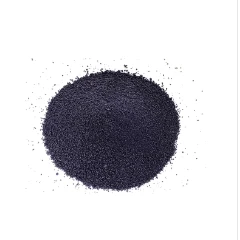sulphur black br 220 service
Understanding Sulphur Black BR 220 A Versatile Dye for Textile Applications
Sulphur Black BR 220 is a prominent dye used primarily in the textile industry, known for its rich, deep black color and excellent fastness properties. This dye is part of the sulphur dye family, characterized by their remarkable ability to produce strong colors on various fibers, particularly cotton and other cellulosic materials. In this article, we will explore the attributes of Sulphur Black BR 220, its applications, advantages, and the importance of safety measures during its use.
Chemical Composition and Characteristics
Sulphur Black BR 220 is a complex compound derived from the chemical sulfonation of various organic materials. The dye is formed through a series of reactions that introduce sulphur groups into its molecular structure, enhancing its affinity for fibers. This particular formulation offers a high degree of lightfastness, washfastness, and rubfastness. As a result, textiles dyed with Sulphur Black BR 220 retain their rich color for extended periods, even after repeated washing and exposure to sunlight.
One of the defining features of Sulphur Black BR 220 is its insolubility in water, which distinguishes it from many other dyes. This property necessitates specific dyeing techniques, generally involving a reduction process to make the dye soluble and capable of penetrating the fiber. Once applied and oxidized, the dye precipitates back to its original insoluble form, firmly attaching itself to the yarn or fabric.
Applications in the Textile Industry
Sulphur Black BR 220 finds vast applications within the textile industry, primarily for dyeing cotton, denim, and other natural fibers. It is particularly popular in the production of jeans and other casual wear, where deep, dark colors are frequently desired. The dye is used in both continuous and batch dyeing processes, accommodating the varied demands of manufacturers.
In addition to textile dyeing, Sulphur Black BR 220 can also be employed in other industries, including leather and paper production. Its ability to adhere effectively to different substrates makes it a versatile choice across various applications. The dye can integrate seamlessly into fabric blends, providing a consistent and aesthetically pleasing finish.
sulphur black br 220 service

Advantages of Sulphur Black BR 220
One of the key advantages of Sulphur Black BR 220 is its cost-effectiveness. Compared to other black dyes, it is relatively inexpensive to produce, allowing manufacturers to achieve significant savings while meeting consumer demands for high-quality dyed products. Furthermore, the dye's durability ensures longer product lifespans, reducing the need for frequent replacements—a hallmark of sustainable production practices.
The environmental impact of Sulphur Black BR 220 is also a consideration in its use. While sulphur dyes are generally less toxic than some synthetic alternatives, responsible management of the dyeing process is crucial. Proper wastewater treatment and chemical handling are essential to mitigate any potential environmental risks associated with the disposal of dyeing effluents.
Safety Measures and Precautions
While Sulphur Black BR 220 presents numerous advantages, workers and handlers must adhere to safety guidelines to ensure a safe working environment. Appropriate personal protective equipment (PPE) should be worn when handling the dye, including gloves, masks, and eye protection. It is also essential to maintain proper ventilation in areas where dyeing occurs to minimize inhalation exposure to fumes or dust.
Employers should train staff on safe handling practices and the importance of adhering to Material Safety Data Sheets (MSDS) for Sulphur Black BR 220. These documents provide critical information regarding the chemical properties, risks, and safety measures associated with the dye.
Conclusion
In summary, Sulphur Black BR 220 is a versatile dye that plays a significant role in the textile industry. Its outstanding fastness properties, cost-effectiveness, and applicability across various materials make it a popular choice for manufacturers. However, awareness of safety practices and environmental responsibility is essential to ensure the well-being of workers and the sustainability of the production process. As the demand for quality textiles continues, understanding dyes like Sulphur Black BR 220 will remain crucial for achieving excellence in textile manufacturing.
-
The Timeless Art of Denim Indigo Dye
NewsJul.01,2025
-
The Rise of Sulfur Dyed Denim
NewsJul.01,2025
-
The Rich Revival of the Best Indigo Dye
NewsJul.01,2025
-
The Enduring Strength of Sulphur Black
NewsJul.01,2025
-
The Ancient Art of Chinese Indigo Dye
NewsJul.01,2025
-
Industry Power of Indigo
NewsJul.01,2025
-
Black Sulfur is Leading the Next Wave
NewsJul.01,2025

Sulphur Black
1.Name: sulphur black; Sulfur Black; Sulphur Black 1;
2.Structure formula:
3.Molecule formula: C6H4N2O5
4.CAS No.: 1326-82-5
5.HS code: 32041911
6.Product specification:Appearance:black phosphorus flakes; black liquid

Bromo Indigo; Vat Bromo-Indigo; C.I.Vat Blue 5
1.Name: Bromo indigo; Vat bromo-indigo; C.I.Vat blue 5;
2.Structure formula:
3.Molecule formula: C16H6Br4N2O2
4.CAS No.: 2475-31-2
5.HS code: 3204151000 6.Major usage and instruction: Be mainly used to dye cotton fabrics.

Indigo Blue Vat Blue
1.Name: indigo blue,vat blue 1,
2.Structure formula:
3.Molecule formula: C16H10N2O2
4.. CAS No.: 482-89-3
5.Molecule weight: 262.62
6.HS code: 3204151000
7.Major usage and instruction: Be mainly used to dye cotton fabrics.

